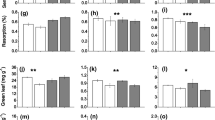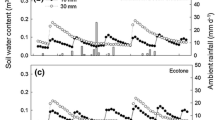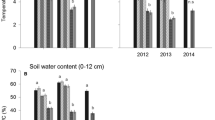Abstract
The success of invasive aridland plants may depend on their utilization of precipitation not fully exploited by native species, which could lead to seasonally altered ecosystem carbon and water fluxes. We measured volumetric soil water across 25-cm profiles (θ25cm) and springtime whole-plant water- and carbon-fluxes of the exotic Lehmann lovegrass (Eragrostis lehmanniana) and a native bunchgrass, bush muhly (Muhlenbergia porteri), following typical (55 mm in 2009) and El Niño-enhanced accumulations (154 mm in 2010) in a SE Arizona savanna. Across both years, θ25cm was higher under lovegrass plots, with similar evapotranspiration (ET) between lovegrass and bush muhly plots. However, in 2010 transpiration (T) was higher in bush muhly than lovegrass, implying higher soil evaporation in lovegrass plots maintained similar ET. Net ecosystem carbon dioxide exchange (NEE) was similar between lovegrass and bush muhly plots in 2009, but was more negative in bush muhly plots following El Niño, indicating greater CO2 assimilation. Ecosystem respiration (R eco) and gross ecosystem photosynthesis (GEP) were similar between lovegrass and bush muhly plots in 2009, but were higher in bush muhly plots in 2010. As a result, lovegrass plots reduced ecosystem water-use efficiency (WUEe = NEE/ET), while bush muhly WUEe remained constant between 2009 and 2010. Concurrent whole-plant WUE (WUEp = GEP/T) did not change in lovegrass plots, but increased in bush muhly plots between these years. We concluded that cool-season precipitation use is not a component of Lehmann lovegrass invasive success, but that the change in ET partitioning and attendant shifts in cool-season WUEe may increase interannual variation in ecosystem water- and carbon-exchange dynamics in the water-limited systems it dominates.





Similar content being viewed by others
References
Anable ME, McClaran MP, Ruyle GB (1992) Spread of introduced Lehmann lovegrass Eragrostis lehmanniana Nees. in Southern Arizona. Biol Conserv 61:181–188
Anderson JE, Toft NL (1993) Depletion of soil moisture by two cold desert bunchgrasses and effects on photosynthetic performance. Great Basin Nat 53:97–106
Anderson JE, Shumar ML, Toft NL, Nowak RS (1987) Control of the soil water balance by sagebrush and three perennial grasses in a cold-desert environment. Arid Soil Res Rehabil 1:229–244
Atkin OK, Tjoelker MG (2003) Thermal acclimation and the dynamic response of plant respiration to temperature. Trends Plant Sci 8:343–351
Bock CE, Bock JH, Jepson KL, Ortega JC (1986) Ecological effects of planting African lovegrasses in Arizona. Nat Geogr Res 2:456–463
Breckenfeld DJ, Robinett D (2003) Soil and ecological sites of the Santa Rita Experimental Range. In: McClaran MP, PF Ffolliot, Edminster CB (eds) Santa Rita Experimental Range: 100 years (1903 to 2003) of accomplishments and contributions, conference proceedings Oct 30–Nov 1, 2003, Tucson AZ, pp 157–165. USDA Rocky Mountain Research Station Proceedings 30, Ogden, UT
Cable DR (1980) Seasonal patterns of soil water recharge and extraction on semidesert ranges. J Range Manage 33:9–15
Caldwell MM, Richards JH, Johnson DA, Nowak RS, Dzurec RS (1981) Coping with herbivory: photosynthetic capacity and resource allocation in two semiarid Agropyron bunchgrasses. Oecologia 50:14–24
Caldwell MM, Dean TJ, Nowak RS, Dzurec RS, Richards JH (1983) Bunchgrass architecture, light interception and water use efficiency: assessment by fiber optic point quadrats and gas exchange. Oecologia 59:178–184
Chen J, Stark JM (2000) Plant species effects on carbon and nitrogen cycling in a sagebrush-crested wheatgrass soil. Soil Biol Biochem 32:47–57
Christensen JH, Hewitson B (2007) Regional climate projections. In: Solomon S, Qin D, Manning M (eds) Climate Change 2007: The Physical Science Basis. Contribution of working group I to the Fourth Assessment Report of the Intergovernmental Panel on Climate Change, pp 487–940. Cambridge University Press, Cambridge
Collins SL, Fargione JE, Crenshaw CL, Nonaka E, Elliot JR, Xia Y, Pockman WT (2010) Rapid plant community composition responses during summer monsoon to nighttime warming in a northern Chihuahuan Desert grassland. J Arid Environ 74:611–617
Cox JR, Ruyle GB (1996) Influence of climate, soil and grazing of the distribution of Lehmann lovegrass. In: Tellman B, Finch DM, Edminster C, Hamre R (eds) The future of arid grasslands: identifying issues, seeking solutions, conference proceedings October 9–13, 1996, Tucson AZ, pp 150–154. USDA Forest Service Rocky Mountain Research Station Proceedings 4, Ogden UT
Cox JR, Ruyle GB, Roundy BA (1990) Lehmann lovegrass in southeastern Arizona: biomass production and disappearance. J Range Manage 43:367–372
DeFalco LA, Fernandez GCJ, Nowak RS (2007) Variation in the establishment of a non-native annual grass influences competitive interactions within Mojave Desert perennials. Biol Invasions 9:293–307
Easterling DR, Meehl GA, Parmesan C, Changnon SA, Karl TR, Mearns LO (2000a) Climate extremes: observations, modeling, and impacts. Science 289:2068–2074
Easterling DR, Evans JL, Groisman PY, Karl TR, Kunkel KE, Ambenje P (2000b) Observed variability and trends in extreme climate events: a brief review. Bull Am Meteorol Soc 81:417–425
Fernandez RJ, Reynolds JF (2000) Potential growth and drought tolerance of eight desert grasses: lack of a trade-off? Oecologia 123:90–98
Flanagan LB, Johnson BG (2005) Interacting effects of temperature, soil moisture and plant biomass on ecosystem respiration in a northern temperate grassland. Ag Forest Meteorol 130:237–253
Flanagan LB, Wever LA, Carlson PJ (2002) Seasonal and interannual variation in carbon dioxide exchange and carbon balance in a northern temperate grassland. Glob Change Biol 8:599–615
Flanders AA, Kuvlesky WP, Ruthven DC, Zaiglin RE, Bingham RL, Fulbright TE, Hernandez F, Brennan LA (2006) Effects of invasive exotic grasses on south Texas rangeland breeding birds. Auk 123:171–182
Frasier GW, Cox JR (1994) Water balance in pure stands of Lehmann lovegrass. J Range Manage 47:373–378
Geiger EL, McPherson GR (2005) Response of semi-desert grasslands invaded by non-native grasses to altered disturbance regimes. J Biogeogr 32:895–902
Geiger EL, Mau-Crimmins T, Schussman H (2003) Spread of a nonnative grass across southern Arizona: Multiple data sources to monitor change. In: McClaran MP, Ffolliot PF, Edminster CB (eds) Santa Rita Experimental Range: 100 years (1903 to 2003) of accomplishments and contributions, conference proceedings Oct 30–Nov 1, 2003, Tucson AZ, pp 116–120. USDA Rocky Mountain Research Station Proceedings 30, Ogden, UT
Hamerlynck EP, Scott RL, Moran MS, Keefer TO, Huxman TE (2010) Growing season ecosystem- and leaf-level gas exchange of an exotic and native semiarid bunchgrass. Oecologia 163:561–570
Hamerlynck EP, Scott RL, Moran MS, Schwander AM, Connor E, Huxman TE (2011) Inter- and under-canopy soil water, leaf-level and whole-plant gas exchange of a semiarid perennial C4 grass. Oecologia 165:17–29
Heisler-White JL, Knapp AK, Kelly EF (2008) Increasing precipitation event size increases aboveground net primary productivity in a semi-arid grassland. Oecologia 158:129–140
Heisler-White JL, Blair JM, Kelly EF, Harmoney K, Knapp AK (2009) Contingent productivity responses to more extreme rainfall regimes across a grassland biome. Glob Change Biol 15:2894–2904
Holmgren M, Lopez BC, Gutierrez JR, Squeo FA (2006) Herbivory and plant growth rate determine the success of El Niño Southern Oscillation-driven tree establishment in semiarid South America. Glob Change Biol 12:2263–2271
Huenneke LF, Anderson JP, Remmenga M, Schlesinger WH (2002) Desertification alters patterns of aboveground primary production in Chihuahuan ecosystems. Glob Change Biol 8:247–264
Huxman TE, Smith SD (2001) Photosynthesis in an invasive grass and native forb at elevated CO2 during an El Niño year in the Mojave Desert. Oecologia 128:193–201
Huxman TE, Cable JM, Ignace DD, Eilts JA, English NB, Weltzin J, Williams DG (2004) Response of net ecosystem gas exchange to a simulated precipitation pulse in a semi-arid grassland: the role of native versus non-native grasses and soil texture. Oecologia 141:295–305
Huxman TE, Wilcox BP, Breshears DD, Scott RL, Snyder KA, Small EE, Hultine K, Pockman WT, Jackson RB (2005) Ecohydrological implications of woody plant encroachment. Ecology 86:308–319
Jacobsen OH, Schjønning P (1993) A laboratory calibration of time domain reflectometry for soil water measurement including effects of bulk density and texture. J Hydrol 151:147–157
Jenerette GD, Scott RL, Huxman TE (2008) Whole ecosystem metabolic pulses following precipitation events. Funct Ecol 22:924–930
Knapp AK, Conard JL, Blair JM (1998) Determinants of soil CO2 flux from a sub-humid grassland: effect of fire and fire history. Ecol Appl 8:760–770
Kurc SA, Small EE (2004) Dynamics of evapotranspiration in semiarid grassland and shrubland ecosystems during the summer monsoon season, central New Mexico. Water Resour Res 40:W09305
Marshall JD, Blair JM, Peters DPC, Okin G, Rango A, Williams M (2008) Predicting and understanding ecosystem responses to climate change at continental scales. Front Ecol Environ 6:273–280
McClaran MP (2003) A century of vegetation change on the Santa Rita Experimental Range. In: McClaran MP, Ffolliot PF, Edminster CB (eds) Santa Rita Experimental Range: 100 years (1903 to 2003) of accomplishments and contributions, conference proceedings Oct 30–Nov 1, 2003, Tucson AZ, pp 16–33. USDA Rocky Mountain Research Station Proceedings 30, Ogden, UT
McKee TB, Doesken NJ, Kleist J (1993) The relationship of drought frequency and duration to time scale. In: Proceedings of the eighth conference on applied climatology, pp 17–22. Am Meteorol Soc, Boston, MA
Miller RF, Donart GB (1981) Response of Muhlenbergia porteri Scribn. to season of defoliation. J Range Manage 34:91–94
Monson RK, Prater MR, Hu J, Burns SP, Sparks JP, Sparks KL, Scott-Denton LE (2010) Tree species effects on ecosystem water-use efficiency in a high-elevation, subalpine forest. Oecologia 162:491–504
Moran MS, Scott RL, Hamerlynck EP, Green KN, Emmerich WE, Holifield-Collins CD (2009) Soil evaporation response to Lehmann lovegrass (Eragrostis lehmanniana) invasion in a semiarid watershed. Agric For Meteorol 149:2133–2142
Mote PW, Hamlet AF, Clark MP, Lettenmaier DP (2005) Declining mountain snowpack in western North America. Bull Am Meteorol Soc 86:39–49
Muldavin EH, Moore DI, Collins SL, Wetherill KR, Lightfoot DC (2008) Aboveground net primary production dynamics in a northern Chihuahuan Desert ecosystem. Oecologia 155:123–132
Neilson RP (1987) Biotic regionalization and climatic controls in western North America. Vegetatio 70:135–147
Ogle SM, Ojima D, Reiners WA (2004) Modeling the impact of exotic annual brome grasses on soil organic storage in northern mixed-grass prairie. Biol Invasions 6:365–377
Patrick L, Cable J, Potts D, Ignace D, Gafford-Barron G, Griffith A, Alpert H, Van Gestel N, Robertson T, Huxman TE, Zak J, Loik ME, Tissue D (2007) Effects of an increase in summer precipitation on leaf, soil, and ecosystem fluxes of CO2 and H2O in a sotol grassland in Big Bend National Park, Texas. Oecologia 151:704–718
Potts DL, Huxman TE, Cable JM, English NB, Ignace DD, Eilts JA, Mason MJ, Weltzin JF, Williams DG (2006) Antecedent moisture and seasonal precipitation influence the response of canopy-scale carbon and water exchange to rainfall pulses in a semi-arid grassland. New Phytol 170:849–860
Prater MR, DeLucia EH (2006) Non-native grasses alter evapotranspiration and energy balance in Great Basin sagebrush communities. Agric For Meteorol 139:154–163
Robertson TR, Zak JC, Tissue DT (2010) Precipitation magnitude and timing differentially affect species richness and plant density in the sotol grassland of the Chihuahuan Desert. Oecologia 162:185–197
Scott RL, Shuttleworth WJ, Keefer TO, Warrick AW (2000) Modeling multiyear observations of soil moisture recharge in the semiarid American Southwest. Water Resour Res 36:2233–2247
Seager R, Ting M, Held I, Kushnir Y, Lu J, Vecchi G, Huang HP, Harnik N, Leetmaa A, Ngar-Cheung L, Li C, Velez J, Naik N (2007) Model projections of an imminent transition to a more arid climate in Southwestern North America. Science 316:1181–1184
Seyfried MS, Schwinning S, Walvoord MA, Pockman WT, Newman BD, Jackson RB, Phillips FM (2005) Ecohydrological control of deep drainage in arid and semiarid regions. Ecology 86:277–287
Sheppard PR, Comrie AC, Packin GD, Angersbach K, Hughes MK (2002) The climate of the US southwest. Climate Res 21:219–238
Smith SD, Monson RM, Anderson JE (1997) Physiological ecology of North American Desert plants. Springer, Berlin
Sponseller RA (2007) Precipitation pulses and soil CO2 fluxes in a Sonoran Desert ecosystem. Glob Change Biol 13:426–436
Taub DR (2000) Climate and the U.S. distribution of C4 grass subfamilies and decarboxylation variants of C4 photosynthesis. Am J Bot 87:1211–1215
Williams DG, Baruch Z (2000) African grass invasion in the Americas: ecosystem consequences and the role of ecophysiology. Biol Invasions 2:123–140
Yepez EA, Huxman TE, Ignace DD, English NB, Weltzin JF, Castellanos AE, Williams DG (2005) Dynamics of transpiration and evaporation following a moisture pulse in semiarid grassland: a chamber-based isotope method for partitioning flux components. Agric For Meteorol 132:359–376
Zar JH (1974) Biostatistical analysis. Prentice-Hall, Englewood Cliffs, p 215
Author information
Authors and Affiliations
Corresponding author
Rights and permissions
About this article
Cite this article
Hamerlynck, E.P., Scott, R.L., Barron-Gafford, G.A. et al. Cool-season whole-plant gas exchange of exotic and native semiarid bunchgrasses. Plant Ecol 213, 1229–1239 (2012). https://doi.org/10.1007/s11258-012-0081-x
Received:
Accepted:
Published:
Issue Date:
DOI: https://doi.org/10.1007/s11258-012-0081-x




